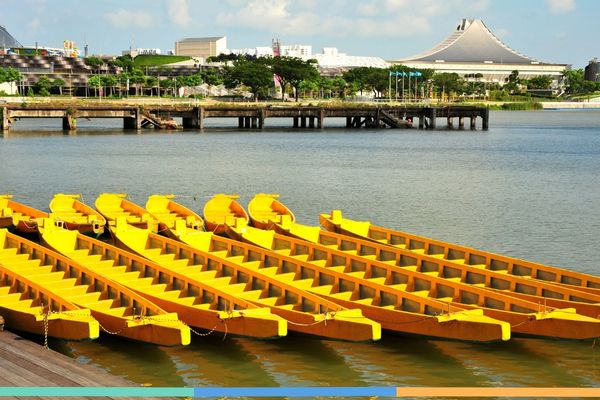Being one of the most visited countries in the world, Singapore surely has a lot of fascinating tourist destinations to visit. If you are keen on visiting natural landmarks such as the rivers, beaches, and so on you should definitely visit Kallang River, one of Singapore’s historical natural wonders. A trip to the historical river could not only refresh your mind but also add up to your knowledge of ASEAN, particularly Singaporean history.
The Kallang River is Singapore’s longest river, starting from the Lower Peirce Reservoir, via Ang Mo Kio, Bishan, Toa Payoh and Geylang Bahru, and ending at the Kallang Basin. The name Kallang had appeared as early as 1835, in a map drawn by George Dromgold Coleman (1795-1844), an Irish architect, planner and surveyor of early Singapore.
Kallang as a place name was derived from one of Singapore’s earliest settlers, orang kallang. Originated from Java, Indonesia, the orang kallang were skillful boat dwellers and had already made their home at the swamps of Sungei Kallang when Sir Stamford Raffles arrived at the island. In 1824, the orang kallang were resettled by the Temenggong of Johor to the Pulai River after Singapore was ceded to the British.


The Orang Kallang were among the indigenous inhabitants of Singapore. They constituted half of the approximately 1,000 residents in Singapore at the time of Raffles’s landing in January 1819. The Orang Kallang were boat-dwellers who lived in the swamps at the mouth of the Kallang River. When Singapore was ceded to the British in 1824, the Temenggong of Johor relocated the Orang Kallang to Pulai River in Johor.
One of the longest-standing landmarks in Kallang is the former Kallang Gasworks, with its distinctive appearance and gas odour. Situated next to Kallang Basin in Kampong Bugis, the location is ideal for coal to be unloaded from barges, small boats and tongkangs on the Rochor and Kallang Rivers. Privately owned by the Singapore Gas Company which was established in 1861, it was the first gasworks in Singapore to provide piped gas for street lights until 1901, when it was taken over by the Municipal Commissioners. By 1940, gas became more commonly used for cooking rather than for street lighting. When the Public Utilities Board took over the supply of electricity, water and gas to the city in 1963, six new plants were added from 1966 to 1981 to increase the production capacity at Kallang. In 1998, Kallang Gasworks was decommissioned after 137 years to make way for urban redevelopment and all piped gas production operations were relocated to a new site and building – Senoko Gasworks, which started operations in July 1997.
Other prominent landmarks in Kallang were the National Stadium (1973–2007) and the Singapore Indoor Stadium (1989) of Singapore. The former Singapore Prime Minister Lee Kuan Yew conducted the official opening of the National Stadium on 21st July 1973. Singapore, after its independence in 1965, finally had a respectable stadium to host local and international events. It soon became an iconic landmark and a source of national pride for the people. Throughout its history, the 55,000-capacity stadium had hosted three Southeast Asian Games and 18 National Day Parades.
Furthermore, Singapore’s iconic Indoor Stadium has hosted a wide variety of sports and entertainment events, including Western and Asian superstars, family entertainment, award shows, sports matches and other large-scale events. It started its first construction on 1 January 1985, and was built at a cost of S$90 million. The arena was designed by Japanese architect Kenzo Tange, and it has a cone shaped roof and a pillarless arena. The Indoor Stadium was finally completed on 1 March 1987 and officially opened to the public on 1 July 1988. On 31 December 1989, Singapore Indoor Stadium was officially opened in an inaugural ceremony by the Prime Minister of Singapore, Lee Kuan Yew.
A visitation to Kallang River during your time in Singapore would be an unforgettable experience. It offers a wide variety of attractions as you will not only be able to enjoy the beauty of the historical Kallang River, but also other entertaining sports-related activities around the river area.
By Vania Safira Evanti, ASEAN Youth Organization
- A Little History along the Kallang River. (2019, December 10). Remember Singapore. https://remembersingapore.org/2016/11/01/kallang-river-history-landmarks/
- cit.
- Coernellius-Takahama, Vernon. Kallang. (2018). Singapore Infopedia: https://eresources.nlb.gov.sg/infopedia/articles/SIP_220__2008-12-02.html
- cit.
- cit.
- A Little History along the Kallang River. (2019, December 10). Remember Singapore. https://remembersingapore.org/2016/11/01/kallang-river-history-landmarks/
- Singapore Indoor Stadium. (2020, June 11). Wikipedia. https://en.wikipedia.org/wiki/Singapore_Indoor_Stadium
- cit.
